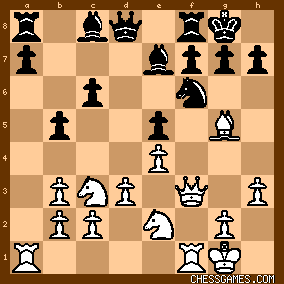| KEG: Gottschall decides to embark upon a tactical struggle against Janowski. Not surprisingly, Janowski prevailed in the sort of game in which he excelled. INdeed, Gottshcall even allowed Janowski to play with two Bishops against two Knights: generally a recipe for disaster against a player celebrated for his tactical abilities with Bishops. 1. e4 e5
2. Nc3
The Vienna Game, a favorite of Mieses. This double-edged opening was a dubious choice when paired against the likes of Janowski (although here Gottschall didn't get into any really serious trouble until his 14th move. 2... Nf6
3. Bc4 Bc6
4. d3
The "usual" move in this position. 4. Nf3 and 4. h3 look better, though there is nothing terribly wrong with the text if White is seeking only equality. 4... d6
5. h3
As MCO-13 notes: "Many moves are plausible here." 5. Nf3 or 5. Na4 seem the most promising options. 5... Nc6
6. f4?!
A wild shot, though in the spirit of the Vienna Game/Gambit. 6. Nf3 is most usual here. White might try 6. Na4. 6... Na5
Unnecessary. Black could obtain the better game with 6...0-0 or 6...a6, and perhaps also with 6...h6. 7. Bb3
He could play for more complications with 7. fxe5, but the text is probably more sensible. 7... c6
8. Qf3 0-0
9. Nge2
Again avoiding playing fxe5. This decision by Gottschall seems sensible. The text gives him an approximately level game. 9... b5
Playing for complications instead of the more solid--and perhaps slightly better 9...Re8 or 9...NxB. 10. fxe5 dxe5
11. Bg5 Be7
12. 0-0 NxB
13. axN
The position was now:

click for larger viewGottschall controls the open file. Janowski has the two Bishops. Chances at this stage were about equal. 13... Be6
13...a5 was probably a bit better.
14. BxN?
This trade is hard to understand, and was the beginning of Gottschall's problems that led to his defeat. Why give up his fine Bishop? And why let Janowski play with two Bishops against two Knights? Janowski--who loved to attack with two Bishops--must have licked his lips when he saw Gottschall's move. 14... BxB
15. Ng3
Another poor move by Gottschall. The g3 square should be left available for the White Queen, and he needed to get his King off the a7..g diagonal. Accordingly, Gottschall should have played either 15. Kh1 or 15. Qg3. 15... Bg5
Tentative play by Janowski. 15...a5 or 15...Qd4 check were better. 16. Ra6
"?"--Tournament Book.
The Tournament Book notwithstanding, the text move is not all that terrible. Perhaps Gottschall should have brought his King to safery here with 16. Kh1 or 16. Kh2. 16... Qd7
16...Bc8 was better. Among other things, it creates a trap (17. Rxc6? Bb7 and the Rook is lost, since if 18. Rc5 Qd4+). 17. Nf5!
A good move in a tough position.
17... g6
17...Bd8 was a good alternative.
The position was now (after 17...g6):

click for larger viewGottschall's position was hardly great, but he was very much in the game here. But at this point Gottschall's desire to attack led him astray and into a lost position, as I will discuss in my next post on this game. | 




































